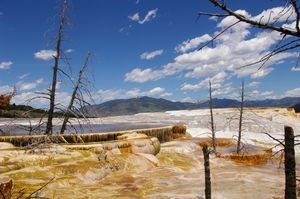Advertisement
Published: November 21st 2007

 Mammoth Hot Springs
Mammoth Hot Springs
A view of Canary SpringsIt hadn't occurred to me until recently that traveling can be a very competitive endeavor. Well, strike that. "Tourist"-ing can be very competitive. Traveling is supposed to be an enriching, relaxing experience, not a cut-throat treasure hunt. And yet I see this behavior in many of our fellow campers and, as much as it shames me to say so, sometimes catch myself acting a little this way myself. The common campfire at which the rangers present nightly talks seem to be the boasting grounds of the days spoils, comparing sightings of osprey, elk and the ever elusive moose. Just for the record, we havn't seen much, if any, of the larger mammalian wildlife in the park; we have been enjoying the simpler things nature has to offer, like the birds singing from the lodgepole pines around our tent as the sun rose higher and higher into the sky, until eventually we pulled ourselves away from our warm and toasty bed and set about for another day of adventuring about three hours later than planned. That's the trouble with an un-planned excursion; you have to plan if you want to see all you want to see, but you can't enjoy yourself if

 Rocky Mountain Wildflowers
Rocky Mountain Wildflowers
In the scheme of purple and gold--Go Huskies!you rush around doing all you want to do. The compromise we've struck with ourselves is to plan the area we'll visit each day, while leaving the specifics up to whim. Sunday we decided to head north and explore the Mammoth Hot Springs and surrounding area.
Mammoth Hot Springs is an every growing expanse of travertine terraces, constructed from slowly deposited calcium carbonate. Unlike the rest of Yellowstone, the underlying bedrock in this area is Limestone, the final remains of an ancient sea that once covered much of North America. As carbon dioxide dissolves into the hot water, it forms a weak carbonic acid, nothing unlike the acid found in the sodas and other carbonated beverages we drink. This acid dissolves the limestone which later precipitates out on the surface, creating the intricate sculptures we see on the surface. Or, in simpler terms, it's like a cave turned inside-out.
Like all natural landmarks, the colors, shapes and activity of the springs vary with the current conditions, and we were a bit dismayed that during our visit the conditions just weren't right. Still we faithfully completed the lower loop making sure to take-in each feature. I wonder what compelled

 Pronghorn
Pronghorn
Nestled among the sagebrush.us to do this? As though we couldn't consider the area of the park completed until we had officially seen what was to be seen. Another check off the list! What has caused us to be "that type" of visitor? Minerva Terrace, immortalized in a few of Yellowstone's most popular postcards, remained dormant while the white, lacey steps merely hinted at former activity. Palette Spring was also a disappointment, unless "palette" was meant to refer to the predominantly orange and brown hues present. Much of the activity seems to have shifted away from the lower terraces and further toward upper terrace, where Canary Spring gave us a close-up look at the orange, greens, whites and yellows blending into one another like watercolors as the hot mineralized water cascaded down the Main Terrace. Locked into the ponds are the remains of trees long ago mineralized as the silica in the water hardened the internal vascular structure. Now solid rock, these trees help tell the history of the changing landscape.
With the viewing of the terraces "complete" (Andras laughs at my terminology here; I'm always so worried about whether things "counted" or not. "Count for what?" he'll say) we headed towards
the Ranger Station to get some input of where best to take a day hike. The ranger suggests the 5-Mile Beaver Ponds Loops and we are more than amenable to the idea as the trail-head is just right across the road a ways. The trail guide she gives us says that the trail climbs for 300ft at the beginning and levels off after that. There is some weather coming in from the south; it still seems far off, but as the darkening clouds begin to gather it does make us a little uneasy, but the trail description sounds relatively simple and we know we can 5 miles without difficulty. The trail climbs forever, it seems, until we level out on the top of the hillside. The wildflowers are in full blooms and cover the mountain in shades of violet, pink and gold. It reminds me of the Mt. Rainier, with the purple lupines and crimson paintbrushes. The flowers fill the air with a soft, sweet aroma that urges us forward. Winding through aspen glades, we spot a Sand Hill crane picking its way through the tall grass below. It's red capped head stands out prominent among the otherwise green background.

 Weather on the Horizen
Weather on the Horizen
From Norris CampgroundAs the trail descends towards the back side of the mountain, I begin to lose steam. My knee has begun to throb with pain and it's making passage forward difficult. Still, going back is an up-hill battle (literally) and we have no idea how far into the loop we've come and thus no way to determine which is the quickest way back. At every pool of water, or nest of branches, I hope that we've finally made it to the Beaver Ponds, but the trail keeps going. Eventually we come upon a small lake, I suppose it could be a large pond, with a clearly defined dam. Another couple has stopped for lunch and we join them. It's nice and quiet here, and were it not for the throbbing in my leg and clouds threatening from above it would make for a very nice afternoon. Their yells break the silence as they point towards the water. They've seen a beaver swim back into the den. We scan the water, but have no such luck. It's gone. We move on.
By the time we've reached the top of the plateau to make our way back the clouds have moved over
us. We brace ourselves against the fierce winds as they knock us back. I turn my face towards the ground and pick my way through the sagebrush, placing one foot in front of the other along the narrow trail only looking up when I run into Andras who has stopped to see what on earth I'm doing. It takes twice the effort to go half as far as we battle the weather. A pronghorn lies in the brush off to the right of the trail; apparently he too has had enough of the wind. We arrive back in Mammoth Springs exhausted and worn-out. A trip into local market yields some cold beers and huckleberry ice-cream--those little tart fruits which pop in your mouth so evocative of summer. We never thought about a bottle opener. Slumped back in the car, parked across the way we end up busting one of the bottles when we try to pop open the top using the door frame. The loss seems tragic--all that ice cold beer spilling out onto the pavement. A screwdriver later yields better results on the second round. The rain begins as soon as we begin driving back to camp and the
temperature begins to drop. A thin layer of polyurethane never sounded so comforting. It's good to be home.
The next morning, the temperature has dropped dramatically, but not enough to keep a container of ice cream frozen in a cooler overnight. A shame. After pushing ourselves too far yesterday, we decide to gear back today and head south towards Old Faithful. Though not the most impressive aspect of the park by far, we feel it is our duty to go and see it erupt if only to say that we have. How could we not? We take a detour to view the Fountain Paint Pots (which ... were dull. I really cannot bring myself to write much more although we did see a Yellow-Bellied Marmot and Andras inadvertently got up close and personal with some pine trees) and then continue down the road to join the masses in the worst traffic jam we've seen all summer. Bumper to bumper we sit, moving a mile or so every half hour. While we wait, we speculate what has happened. Maybe someone hit a bear? Maybe there's a huge bottleneck over those damn deer again? Turns out a herd of buffalo decided

 Doublet Pool
Doublet Pool
Near Old Faithfulto cross the road and...well they didn't tell us why, so that punchline will forever go unanswered. The Rangers were trying to clear the roadway without causing a stampede--a good decision if you ask me. We reach Old Faithful a little while before the next eruption and view the surrounding geothermal features, many of which are quite interesting but with all the geysers and hot-springs and fumaroles we've seen the past few days we're becoming desensitized. Although the most popular viewing area is on the bleachers, arranged as though we were watching a sporting event with several hundred other people, we opt to walk around the trail a view it from the opposite side. As we congratulate ourselves for being so clever, the geyser bursts it's steaming liquid contents into the air with a thunderous force. It is all we imaged it to be--and then we realize the wind is blowing right towards us. We watch the eruption as we run further and further down the trail, trying to avoid the wet spray that is coating our faces and camera lens. I have to say it was much more of an experience than watching from the stands! The water begins

 Thermophilic Bacteria
Thermophilic Bacteria
A close up of the terraces at Canary Springto rush down the sides of the geyser under the platform and down towards the earth. I am tempted to touch the water, but am reminded what the ranger said at the campfire talk we went to last night. "Now I don't expect that you all are scientists, but this" he said as he held up his finger, "is not a thermometer. I will tell you right now, if its bubbling, if it's boiling, it's hot. Just trust me." Now that's some sage advice to end on.
Advertisement
Tot: 0.227s; Tpl: 0.016s; cc: 19; qc: 112; dbt: 0.1242s; 1; m:domysql w:travelblog (10.17.0.13); sld: 1;
; mem: 1.4mb
















